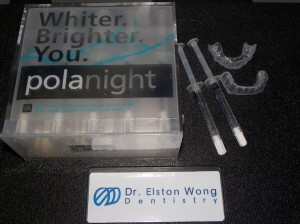Barrie dentist: tooth whitening or bleaching options at a (whiter) glance
Posted: July 20, 2014
Last Modified: March 19, 2021
Tooth bleaching, or tooth whitening, is a commonplace, everyday procedure that can quickly and safely transform a smile into something that one can readily show off. Read on to get our take on this, and perhaps you too can take advantage of this treatment.
Discolouration of teeth can occur due to a variety of reasons. Over time teeth can become discoloured by foods we eat, drinks such as coffee, tea, red wine and by the foods we eat. These are generally regarded as extrinsic, or external stains.
Accidents can also cause discolouration of a single tooth – a blow that has caused internal bleeding in a tooth will result in a darker yellow or brown/ grey tooth like a bruise that never clears up. These are internal stains.
Finally, there are some unfortunate children who were given tetracycline antibiotics at the time of tooth development and have had discoloured teeth since before they ever came into the mouth. These are also intrinsic stains, and are very difficult to whiten because the colour is from the actual colour of the tooth structure.
So, what are the available options for these types of discolouration? (We are assuming that people are wanting whitening and not darkening of their teeth. If you want to darken your teeth, you need to read this).
The natural colour of teeth falls within a range of light greyish to yellow shades, but the perception of the colouring of teeth is significantly affected by skin tone. In order to have “white teeth”, the actual shade of the teeth is not as important as the difference between tooth shade and skin pigmentation. Give a dark-skinned person very white teeth, and they end up looking like the teeth are too white (unless we are talking about California, where it’s never white enough). A frequently-referenced article from the Journal of the American Dental Association says that the whitest teeth are not necessarily the most attractive.
For extrinsic stains
Surface Whiteners use special abrasives or stain inhibitors to improve a product’s ability to remove surface stains from food or tobacco. Examples are whitening toothpastes or chewing gum; and can be found over the counter. These may work to some limited degree, but due to lesser exposure time, the results will not be as dramatic as bleaching / whitening gels.
Bleaching gels are applied directly to teeth surfaces and are required to remain on the teeth for a duration of time each day, typically for a period of 2-3 weeks. Most tooth whitening products are peroxide-based and are capable of altering the colours of the tooth itself. Tooth sensitivity and irritation to soft tissues can occur during treatment but the effects are transient. There are a variety of bleaching products available over the counter (such as whitestrips & gels) or from your dental office. The professional bleaching products available from dental offices have higher concentrations of peroxide gel and typically provide longer-lasting results.
The 2 main techniques of whitening teeth professionally include:
1. In-office whitening: uses a higher concentration of peroxide gel applied by a hygienist. In this one-appointment dental procedure, a light polishing is provided first, then the hygienist isolates the teeth by applying either a gel onto the gum tissues or a rubber dam. After the gums are protected, whitening gel is placed onto the teeth and either a laser or high-intensity light is used to activate the gel. This is typically done a few times during the procedure. The patient is then sent home with a follow-up take-home kit and custom fitted trays to improve results. Sensitivity is a little more pronounced with this technique, but it is ideal for those who want quick results without much home compliance .
2. Home-use (Take-home) Kits: uses a slightly lower concentration of peroxide gel than the in-office treatments. The patient is custom fitted with trays, which are worn 1-2 times per day for typically 2-3 weeks. Results may vary greatly as it is up to the patient to be diligent in wearing the trays and following through with the treatments. A photo of a representative whitening kit is shown below. NOTE: any profits at Dr. Elston Wong Dentistry derived from home whitening are donated to The Royal Victoria Hospital, so whiten your teeth and do some good!

Intrinsic stains
When a tooth is dark as a result of trauma, and anroot canal needs to be done, it is possible to whiten a tooth from the inside after the root canal.
With intrinsic bleaching or whitening, the affected tooth is whitened from the inside out. This procedure involves accessing the inside of the tooth (where the root canal access was located) and applying cotton pellets soaked in whitening gel. The gel’s whitening effect percolates through the tooth and whitens into the tooth structure. These gel- soaked pellets are left within the tooth and changed weekly until the desired result is obtained, usually taking two weeks.
For tetracycline-related staining, whitening these types of teeth is very difficult because the actual internal tooth structure is dark. Whitening may have some mild effect, but the deeper stain will still leave dark teeth. In severe cases, the best treatment may in fact be whitening, followed by veneers or crowns to physical block out the darkness.
Not all discolourations respond to bleaching treatments. Talk to our staff for the best treatment for your specific situation. Bleaching your teeth can improve the appearance of your teeth and give you a more confident smile! For advice on bleaching or an overall comprehensive oral exam, just contact us! We’d love to be your dentist in Barrie.


